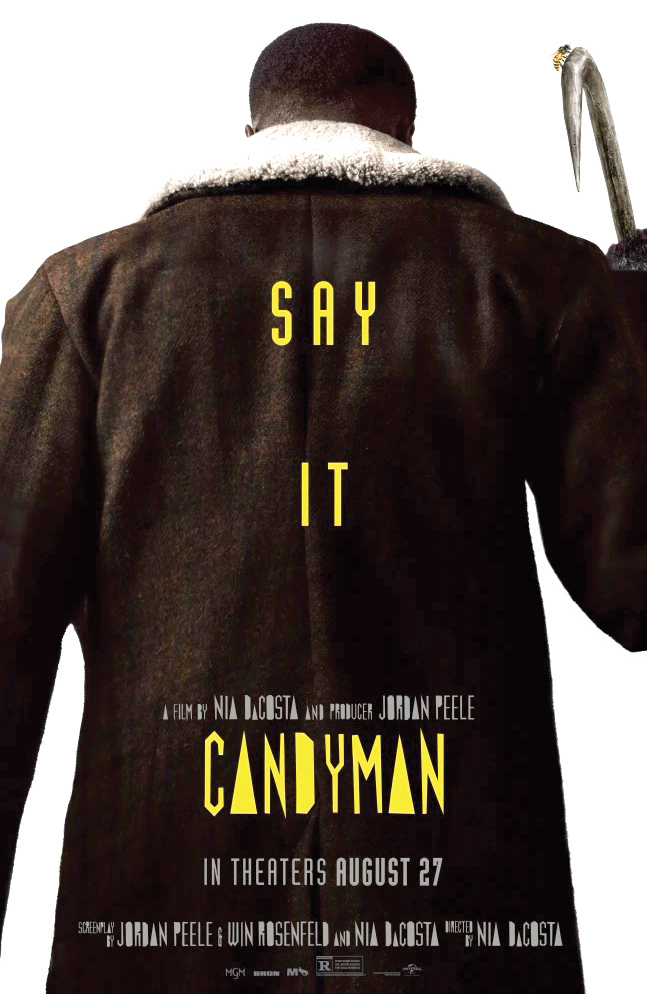By Anansi
Jackson Advocate Entertainment Writer
The remake of Candyman (2021), directed by Nia Dacosta and written by Jordan Peele, uses the element of horror to show viewers the insensitive injustices that are done to the Black body, particularly to men of color. The setting is Cabrini Green 2019, a once Black suburban housing project that is now gentrified and occupied by white people. The city symbolizes the thin line between the past and the present, as all the racial issues that African Americans have gone through in the past have been rebranded and used to disenfranchise African Americans in the present.
What Dacosta has done is incredible! Displaying racism in a supernatural element that exists outside of the movie screen and showing the consequences. Yahya Abdul-Mateen II embodies Anthony McCoy to his core.
As a struggling artist that is trying to live up to his girlfriend’s (Briana Cartwright, played by Teyonah Parris) expectations, the new Cabrini Green residents, mostly now white inhabitants, mock and reject McCoy’s artwork. McCoy begins to desperately seek inspiration. So influenced by the multiple narratives that he hears from his peers across the new Cabrini Green and the creepy laundry man, William Burke, who is played by Colman Domingo, McCoy, breaks through his artist block and conjures Candyman to the present through his art. Eventually, this prompts those around him to become suspicious of him when murders begin to appear in Cabrini Green once again. McCoy’s life is turned upside down as the gentrified Cabrini Green is once again terrorized by the Candyman. Also, the secret that connects McCoy to Candyman is revealed.
Candyman is a contradictory figure. On one hand, Candyman is a vengeful spirit that slashes and kills anyone that disrespects his name by calling it five times in the mirror. On the other, he is what Tony Morrison referred to in the 1987 novel Beloved as a “rememory”.
In the 2021 reboot of Candyman, Candyman is a constant embodiment of “the hive” – those who have been done wrong due to the political, economic, and social injustices of African Americans. As Burke explains at the ending of the movie, Candyman is the only thing that keeps the old Cabrini Green alive: a constant reminder that sustains the injustices that Blacks suffer at the hands of whiteness in the forefront of people’s minds. Because of that, Candyman’s character is a paradox: a monster but a hero that keeps the soul of the Black Cabrini alive.
In her review for Vulture, Angelica Jade Bastien called Candyman, “The most disappointing film of the year so far, limiting not only the artistic failures of the individuals who ushered it to life, but the artistic failures of an entire industry that seeks to commodify Blackness to embolden its bottom line.” I completely disagree with this statement. Candyman served its purpose.
The deaths are carried in proper fashion: quick and painful before the blood dries from their mouths. The laughter and mockery, as those who dare say his name, is replaced with screams. But most importantly, Candyman serves as a movie of healing. As viewers, we are allowed to see how narratives are manipulated and controlled, and how these lies have consequences to the oppressed and the oppressors. We are allowed to participate with McCoy’s and Parris’s characters, from these characters are not just a representation of themselves, but a representation of the entire Black community that they have grown from.
We are allowed to see how silence in the Black family can be proven fatal, as McCoy doesn’t know who he is until his mother finally breaks, and by then it was far too late.
The unfair condition of Blacks and the facilitators of said conditions are now on the big film, no longer hidden. We see how the machine of oppression works against Black bodies, and we can aid in stopping it. The idea of flight that resonates within Cartwright’s character and how flight is shown within each person cursed to be Candyman. We can laugh. We can cry. We can get angry. We can let whatever we feel about the situation out on the movie screen. Then afterward, we can begin to heal because Candyman is loaded with a lot of representation of Black trauma.
As the different version of Candyman pops and slashes throughout the film, an overarching theme resonates through its content. Candyman isn’t just a harbinger of death, a vengeful spirit out to kill everyone. Candyman is a creation, a created cycle for lack of a better description. He is America’s Frankenstein – the monster it created.
I would rate the Candyman reboot 9.5 of 10, and a must see for those who enjoy terror and symbolic learning just as much as I do.






